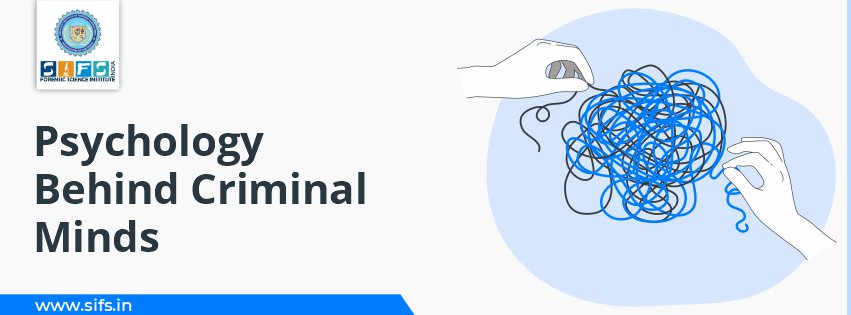- Call Us: +91 7303913002
- Email Us: education@sifs.in
Psychology Behind Criminal Minds

BY SIFS India | January 31, 2025
Psychology Behind Criminal Minds
With the introduction of TV shows like “Criminal Minds” and other popular shows, it’s fascinating to mention many have an interest in the psychology of criminality. On seeing from the outside, offenders are available in all shapes, sizes, colours and ages.
Criminal psychology is the study of criminal mind and psyche work.
Criminal psychology experts work with enforcement agencies to assist solve crimes and perform psychological assessments of convicted offenders and develop psychological treatment plans.
There are biological risk factors that psychologists have linked to violence, and the interventions they need to take to cut back that risk.
Criminal Mind Definition
11-year-old boy kills a 9-year-old in Texas’; a person shoots his wife to death after a family difference in Florida; a man in Chicago admits to killing 12 prostitutes after having sex with them in his hotel room’, etc. Such triggering statements grace our newspaper headlines in this society.
At the age of 5, six or fourteen parents never knew that their child, whom they adore dearly would communicate be a rapist, terrorist, manslayer, etc. Some parents of criminal offenders have the power to reflect on the lives of their children and recall certain behavioural acts and attitudes.
Seen as predictors of future trouble with the son or daughter.
For instance, a superb mathematician and a social critic from class America, Ted had developed some unusual behaviours during his childhood that would have signalled some warning signs of maladaptive development.
The mother reckoned that Ted’s childhood life and upbringing may have contributed to his criminal act.
She states that Ted started developing a solitary lifestyle, empty of friends. He was defiant towards systems, and always criticized routines, sometimes even failing to try and do assignments given to him by his mother.
He also believed in his ability and saw anyone who challenged him as bad and deserves punishment. Although a number of his mother’s recalled history may are distorted by the lens of your time, it’s evident that it had a significant impact on his adulthood.
These traits appear in certain patterns of psychological development, and social history, further as features of maladjustment observed in many criminals (Cassel & Bernstein, 2007; Maguire, Morgan & Reiner, 2007). It’s possible to think that Ted could be a typically developed criminal mind.
Brain Reprogramming to Change Behavior
With the emergence of brain scanning technologies like functional resonance imaging (fMRI), researchers have located active brain areas while individuals perform certain tasks and behaviors.
Darby et al. published a neurocriminology study that has shed light on the brain’s relationship with criminal behaviour. Past studies have analysed this behaviour by studying head injuries, brain lesions, and structural neuro imaging.
They need provided strong evidence that damage to lobe of the brain corresponds with violent behaviour and aggression. Darby is unclear that the lesion to the lobe or related are concerned with criminality.
Darby et al. uses a method called “lesion network mapping” to work out that these damaged islands are connected through a network of neural bridges.
As an example, in a very experiment conducted Eighty-three children were assigned to an experimental enrichment program from ages 3 to five years and matched on temperament, nutritional, cognitive, autonomic, and demographic variables with 355 children who experienced usual community conditions (control group).
Both self-report and objective measures of personality disorder and antisocial behavior were obtained when the topics were ages 17 and 23 years.
Because the results of the program the themes at the age of 3-5 years had lower scores for antisocial behaviors at age of 17 years and criminal behavior at 23 years, compared with the controlled subjects.
The beneficial effects of the method were greater for kids who showed signs of malnutrition study on at the age of three, particularly with relevancy outcomes for schizotypy at ages 17 and 23 and for antisocial behavior at age 17.
How Drugs and Violence Affect the Criminal Mind?
Those who commit crimes are not only violent but also addicted to alcohol and other drugs. This makes it hard to work out which brain changes are associated with addiction and which are connected with brutal behaviour.
A new study aimed in studying the differences between four groups by comparing them: violent offenders who were addicted to drugs; the rare violent offenders who were not; nonviolent people with alcohol or other drug problems; and those who were neither violent nor addicted.
These brain scans suggest that drug misuse is linked with reduced brain volume in areas of the cortex that are involved with self-control.
Grey matter volumes of the prefrontal cortex were reduced due to substance use disorders, not violence or psychopathy as has been previously suggested,” says Boris Schiffer.
Cognitive Theory
Cognitive theory is an approach to psychology that attempts to clarify human behaviour by understanding your thought processes. Cognitive theorists suggest three levels of a process called as moral development.
Pre-Conventional Level: This involves children and the way they external consequences of their actions.
Conventional Level: This involves teens and young adults, who begin to base behaviour on society’s views and expectations.
Post-Conventional Level: Over the age of 20, the main focus is more on judging the moral worth of societal values and rules and the way they relate to values of liberty, human welfare and human rights.
Note - The figures and images used in this blog are only for educational purposes.
Written by: Aparna Krishna U

